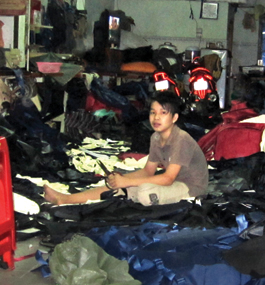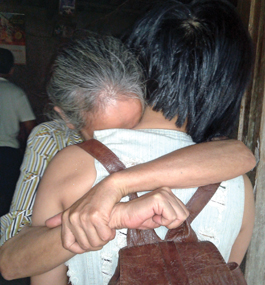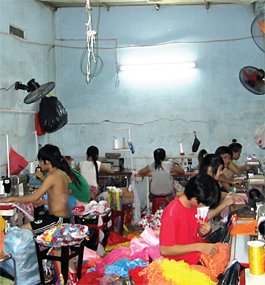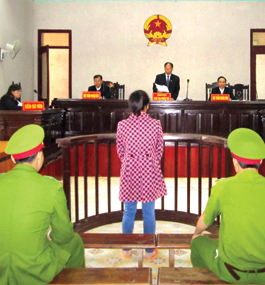A Necessary Hero
Van Ta, Heller MA/SID’12, reaches into darkness to rescue lost children and young women in Vietnam and China.

Courtesy Blue Dragon Children's Foundation
STOLEN CHILDHOOD: Children as young as 10 are trafficked to work in garment factories in Southern Vietnam.
by Claire Pavlik Purgus and Susan Piland
Twenty-five-year-old Chi needed a job, and jobs are hard to find in Dien Bien, the poorest province in Vietnam, located about seven hours by car to the northwest of Hanoi.
So when a neighbor introduced her to a friendly woman who knew of a well-paying job planting mushrooms in China, Chi jumped. But after she and the woman got to China, Chi (not her real name) learned a devastating truth: She’d been duped by a human trafficker. Quickly sold to a father-son team, Chi was forced to marry the younger man and enter the sex trade.
Back in Vietnam, Chi’s relatives were desperate to get her back. Her mother knew her cellphone number but not much else — Chi didn’t speak Chinese and had no idea where she was.
“Many times, I went to visit the family of the girl,” says Van Ta, Heller MA/SID’12, a 31-year-old Vietnamese lawyer.
Van Ta (this story does not include his full name or photo, to protect his anonymity and safety) works with Blue Dragon Children’s Foundation, an Australian charity headquartered in Hanoi that reaches out to disadvantaged children and young people, including those who fall prey to traffickers, and brings human-rights violators to justice. Van Ta’s work isn’t confined to a courtroom. Last year alone, he went to China on seven rescue missions, freeing 13 girls and women who had been sold into prostitution. Chi was one of them.
To locate the disappeared, the Blue Dragon team mixes old-fashioned gumshoe techniques with GPS tracking and other advanced technologies. Van Ta won’t discuss how or where Chi was found except to say it was about 7,000 kilometers (more than 4,300 miles) into China from the Vietnamese border. To bring her home, the team would have to cover a lot of foreign territory, where a lot could go wrong.
“It’s only when we are very sure of where a girl is that we make a plan and go,” says Van Ta. “I had a photo of Chi and a letter from her mother, which I could use to convince her she could trust me.”
Chi agreed to meet the team at a restaurant near the brothel where she’d been living for six months. “We had to be very careful because we had no way of knowing if she would be there alone or accompanied by a trafficker,” Van Ta says. “She was worth at least $6,000 a month to them. If they caught me, they would kill me. So I was very afraid of walking into a trap.”
On the appointed day, around noon, about four months after they first heard about Chi, Van Ta and his team sat in a car outside the brothel. When he saw Chi walk out of the building alone and head for the restaurant, he texted her, asking her to come directly to the car. He showed her the photo and the letter her mother had given him. “And then we were off as fast as we could, heading for the Vietnam border,” he says.
It took them five days to get there — “very stressful days,” Van Ta says, “because we were always worried we might be followed by the traffickers and caught. We can’t rest until we get across the border.” He sighs softly, remembering the journey. “But the stress of the rescue is forgotten as soon as we reunite the girl with her family. Then there is much joy and crying. There is relief.”
Once she was home, Chi revealed something she hadn’t yet told her family: She was pregnant.

Courtesy Blue Dragon Children's Foundation
"MUCH JOY AND CRYING": A Vietnamese mother reunites with her daughter, rescued from a brothel in China.
page 2 of 4
The tentacles of China’s sex trade
Blue Dragon, which has a staff of 65, provides a variety of services to approximately 1,500 Vietnamese children and women every year. Now that Chi is home, the organization is giving her psychological counseling and health care, and will cover her hospital expenses when she has her baby. Eventually, it will help her establish her own small business so she can be self-sufficient.
It’s possible Chi will marry in the future, Van Ta says, or she might not. “It all depends on her. Either way, we will help her heal and become independent.
“Chi is very lucky to have a loving family who understands,” he says. “And we are lucky we were able to find her. When we came back to Vietnam, Chi said to me, ‘You gave me a new life, so I want to help this baby to have a new life, too.’ She asked me to become a godfather, which rarely happens in my culture.”
Not long ago, Van Ta went to Dien Bien province to testify against Chi’s trafficker, the woman who had lied about the mushroom planting job. He says the woman cried when she heard her sentence — 11 years.
Incredibly, not one of Van Ta’s rescue attempts has failed. “Forty percent of my time is dedicated to rescue work,” he says. “It is very time-consuming. Sometimes I know just the city where the parents think the child was taken. Sometimes I don’t even know that.”
He and his team are careful not to alert traffickers that a search is on. “The girl could be moved to Macau or northern China, or to Beijing, where there is a mass market of prostituted persons,” Van Ta says. “From these places, we might never hear from her again.”
Prostitution is illegal but widespread in China. Observers estimate there are as many as 10 million prostituted persons in the country, a number some think is kept high by the country’s one-child policy. In China, the ratio of men to women between the ages of 15 and 64 is 1.06 to 1, which translates to 45.4 million more men than women in this age range. Women, in other words, are in high demand.
“Organized criminal networks in both China and Vietnam cooperate to kidnap young women and some boys into China,” says Phillip Martin, a senior reporter at WGBH Boston Public Radio who’s also an adjunct lecturer in the Sustainable International Development (SID) graduate program at the Heller School and a senior fellow at Brandeis’ Schuster Institute for Investigative Journalism.
 |
|
Sidebar Stories |
 |
In 2012, Martin spent a week with Van Ta in Vietnam for a WGBH Radio series on human trafficking (see sidebar link, at right). He says he’s been told the brothels in southern China are filled with Vietnamese girls.
Some experts also view forced marriage, another prevalent problem, as a human-trafficking issue. Though it’s a difficult situation to track and quantify, Van Ta says Vietnamese women and girls are routinely taken into China without their knowledge or permission and forced into marriage with Chinese men.

Courtesy Blue Dragon Children's Foundation
FACTORY LIFE: Young garment workers — who may eat, sleep and labor in the same room — often suffer from malnutrition, damaged eyesight or back injuries.
page 3 of 4
Cheap clothes, slave conditions
Human trafficking is a mutable term. For instance, it doesn’t necessarily involve the relocation of a victim. But it always includes an element of entrapment, and almost always involves exploitation for another person’s economic benefit. Broadly speaking, human trafficking is the movement of people — usually through coercion, trickery or abduction — into circumstances they cannot easily escape, in which they are exploited for others’ economic gain. Many trafficking victims are abused. Often they or their families are threatened with violence.
Forced labor is a kind of trafficking that affects girls and boys, women and men alike. To supply cheap labor to garment factory owners, traffickers trick, trap and kidnap street kids and runaways.
Martin recalls a night of driving around Ho Chi Minh City with Van Ta, who pointed out the garment factories from which he had rescued children.
“At 2 or 3 o’clock in the middle of the night, you see groups of men hanging out outside, almost as if they were monitoring the buildings,” says Martin. “The factories look more like apartments, with heavy gated barriers in front. Through the gates, you can see kids sewing garments.
“That was a memorable experience,” he says, “that drive into the dark night to witness children who were probably tired and hungry, behind locked and patrolled gates, hunched over sewing machines or hand-sewing with needles and thread. They work 16-hour days and get paid less than a dollar a day, and that’s only after they’ve put in two years of service.”
In 2013, Blue Dragon freed 70 children from garment factories and returned them to their families. With the overwhelming numbers of children trapped in exploitative working conditions in Vietnam, Van Ta and his Blue Dragon colleagues know that’s just a drop in the bucket.
“There has to be another solution,” Martin says. “Rescuing or buying kids out of their situations is not going to do it. Rescue work is incremental. It helps Americans connect the dots between child labor and our consumer appetite for cheap clothing. But simply rescuing these kids one by one can’t fix the whole problem.”
So, in addition to its rescue operations, Blue Dragon uses the court system to go after human traffickers. It also holds policy discussions with government representatives, law enforcement personnel, NGO heads and others, to talk collaboratively about child labor and other topics related to disenfranchised children and workers.
“We are working toward ending the problem of child labor,” says Van Ta. “We believe that in a few years we might be able to stop factories from exploiting children in this way.”
On a broader legal front, the group runs a legal advocacy service for children and families in conflict with the law, the only such service in Vietnam, Van Ta says.
“Anyone in need can come to us and seek help,” he says. “Two lawyers work with me, and we deal with hundreds of cases each year, ranging from people who need birth certificates to teenagers who have been arrested.”

Courtesy Blue Dragon Children's Foundation
IN CUSTODY: Vietnamese police testified in court against Chi's trafficker, who received an 11-year prison sentence.
page 4 of 4
Reclaiming human dignity
Standing about 5 feet 4 inches, the average height for a Vietnamese man, Van Ta cuts an unimposing figure. At work, his colleagues say, his manner is both warm and focused.
Laurence Simon, professor in and director of the Heller School’s SID graduate program, says Van Ta is one of the program’s most extraordinary alumni.
“Part of Van’s success in difficult situations — for example, when he’s negotiating his passage with police on either side of the China-Vietnam border — is he doesn’t appear threatening,” Simon says. “He’s a modest kind of person. People who could be potential obstacles intuitively understand Van’s deep commitment to human dignity and to reclaiming it for those who’ve been stripped of it.”
Says Martin, “If I had to choose two words to describe Van, it would be ‘dedicated’ and ‘relentless.’”
Growing up in a poor farming family inspired his drive to help others, Van Ta says. As a child, he bicycled 28 kilometers to a job in a pottery workshop to earn money for school fees for his younger brother and himself. “I worked from 7 in the morning until 6 in the evening, and earned 50 cents a day,” he says. “Like many families in my village, we usually did not have enough food to eat. Some of my friends left school to support their families, but we did not.”
He says he “started to dream of becoming a person who can protect minorities and the undefended in society” after seeing a lawyer wearing “a black suit and white glasses” representing someone in court before a five-judge panel. Eventually, Van Ta entered the Hanoi University of Law, where he earned a Bachelor of Law.
Having learned English in school, as many Vietnamese students do, Van Ta wanted to keep improving his fluency. At a festival for blind children, he met Michael Brosowski, the Australian teacher who founded Blue Dragon, who was happy to become a conversation partner. In 2005, Van Ta took a job at Blue Dragon.
He got to know Simon through their mutual connection to Streets International, a training program for street kids in Hôi An, which led to Van Ta’s coming to America for a master’s in the SID program at Heller. “The most difficult part of being at Brandeis,” says Van Ta, the father of two, “was being away from my family.”
Life in America surprised him. “Boston is more peaceful than I thought,” he says. “And I never thought the family relationship was so tight in the United States until I saw my professor look after his ill brother at home. We do not see these stories about Americans in Hollywood films.”
The learning environment at the SID program is an ideal laboratory for tackling problems like human trafficking. “Being in the SID community helps students realize that many of the situations they deal with in their own countries are common and need global solutions,” says Simon.
Van Ta says today that his SID studies gave him both “advanced knowledge and practical skills.”
The proof is in the numbers. Before coming to Brandeis, Van Ta rescued 90 victims of trafficking between 2005-10. Since he earned his master’s in May 2012, he says his team has rescued more than 200 victims — “four times more than what we were able to achieve before.” He attributes much of that success to two new anti-trafficking programs his SID training helped him develop.
Simon shakes his head in wonderment when talking about Van Ta’s rescue efforts. “Poor guy, he’s often getting arrested,” he says. “Sometimes they mistake Van for a human trafficker, and it takes a lot of explanation and convincing before police understand what he’s doing.”
“Understandably, Van’s wife is always worried when he’s called out,” says Martin. “Everyone worries for Van’s safety. Van tries to soothe those worries away. Mostly, his worries are focused on the girl he’s going to try to bring home.”
A family man, Van Ta says the best part of his day is when he’s with his wife and kids at home in Hanoi, a city filled with traffic noises, bird songs and the squawk of chickens.
“I wake up to the smell of coffee — I love coffee — and the sounds of my family and the city outside,” he says.
But the dedication to his work never wavers. “There is no part of my work that I don’t like,” he says. “It is all meaningful. The best part of a rescue mission is the moment when the girls come home and are held in their parents’ arms. They all burst into tears — I understand how happy they are.
“They have trauma and tons of difficulties ahead,” he says. “However, we will supply them with ongoing help, so they can reintegrate with the community and have a brighter life.
“Because the most important thing is that they have returned home.”
Claire Pavlik Purgus is managing editor at Brandeis’ Schuster Institute for Investigative Journalism, where she researches and reports for the Human Trafficking and Modern-Day Slavery Project.
